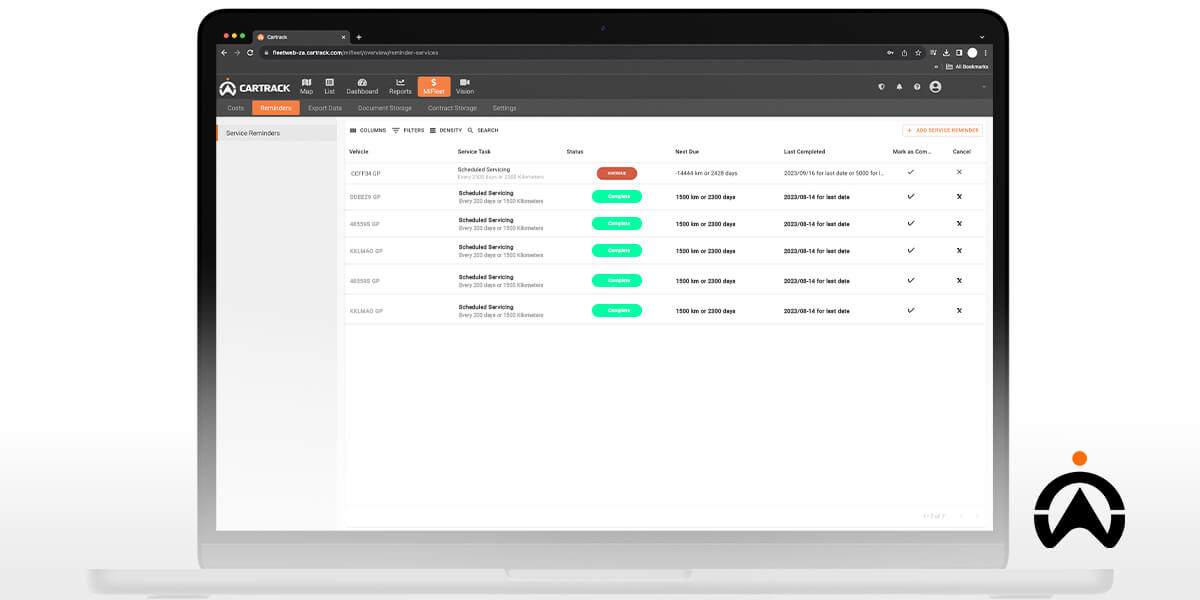- Solutions
- The Company
- About usCartrack offers smart fleet solutions guaranteed to optimise your fleet and workforce, no matter how big or small your business.
- Investor RelationsCartrack has a history of strong cash flow generation and cash conversion, low financial leverage and strong dividends.
- CareersCareers portal. View all the current Cartrack career openings and opportunities available.
- Resources
- Contact Us
- Bahasa
- Login
How To Reduce Fleet Vehicle Downtime And Keep Your Business Running

---- 2024/01/19 ---
What is vehicle downtime?
Vehicle downtime is one of the most costly and disruptive issues for fleet managers. It refers to the period when a business vehicle is not available for use for various reasons. While planned downtime is when a vehicle’s unavailability is scheduled at a company’s convenience, unplanned downtime is a lapse in operations that happens outside of a fleet manager’s control. During this period of inactivity, fleet vehicles are unable to fulfil their duties.
What causes vehicle downtime?
Vehicle downtime can be triggered for several reasons, here are a few:
Accidents or collisions: Vehicles involved in accidents may require significant repairs, which ultimately leads to unplanned downtime.
Fuel-related problems: Unexpectedly running out of fuel or encountering issues with a vehicle’s fuel system can cause delays, which can be costly, especially in the delivery service industry.
Lack of maintenance: Vehicle parts wear out and get damaged, causing vehicles to break down. Not adhering to regular maintenance schedules can lead to unexpected breakdowns or failures that could have been prevented with proper upkeep.
Driver-related incidents: Issues caused by driver errors, such as distracted driving, incorrect operation of equipment, negligence, and incorrect handling, can lead to unforeseen vehicle problems and subsequent downtime.
Road conditions: Potholes, rough roads, and debris can cause damage to the vehicle’s undercarriage, suspension, and tyres, leading to unplanned vehicle downtime.
Impact of downtime in fleet management
Downtime affects a fleet in numerous ways, including:
- Decreased productivity: Since vehicles are not operational, downtime leads to reduced fleet productivity. This means you are missing deliveries or service appointments, making your entire business fall behind schedule. This delay in operations leaks into customer satisfaction, negatively impacting it and your business’ reputation. While it may seem like rushing to make up for lost time and productivity is the solution, this can lead to compromised safety protocols, increasing the risk of accidents or equipment failure.
- Overutilisation of other vehicles: When a vehicle is not operational, fleets may opt to use their other vehicles more to make up for time lost. While this may seem like the ideal quick fix, it can end up causing more damage, as using assets beyond the scheduled times can put a strain on their health and longevity.
- Loss of revenue: Vehicle downtime significantly affects a business’s bottom line. The failure to deliver goods or services on time can lead to a loss of revenue and missed opportunities. This doesn’t just lead to missed deadlines; it also leads to dissatisfied customers who end up taking their business elsewhere. Losing revenue also means you aren’t able to pay your drivers well, which negatively impacts driver morale and retention.
- Increased costs: Repairing vehicles and managing unexpected downtime can significantly increase a fleet’s operational costs. Unexpected breakdowns aren’t usually budgeted for, so fleet managers may have to dip into other parts of business finances to ensure that the repairs are swiftly attended to.
What are the benefits of reducing vehicle downtime?
Reducing vehicle downtime is beneficial for a range of reasons, including:
- Increasing productivity: Reduced vehicle downtime allows for more efficient use of time, enabling vehicles to remain operational and contributing to higher productivity levels.
- Improving customer satisfaction: Reduced vehicle downtime leads to more reliable service and timely deliveries, which enhance customer satisfaction and loyalty.
- Promoting cost savings: Reduced vehicle downtime means fewer maintenance-related expenses, lower repair costs, and decreased spending on emergency repairs. This ultimately saves your fleet money.
- Enhancing safety: Reduced vehicle downtime contributes to safer vehicles, decreasing the likelihood of accidents due to faulty equipment and mechanical issues.
- Aiding better planning and scheduling: Reduced vehicle downtime allows for more accurate scheduling and planning of routes and services since there are no unforeseen delays. This leads to smoother operations and improved efficiency.
- Optimising asset utilisation: Vehicles that spend less time out of commission are utilised more effectively, increasing the overall efficiency and profitability of the fleet.
- Boost driver satisfaction: Vehicles that constantly break down and cause delays negatively impact your driver’s performance and general morale. Reduced vehicle downtime improves their morale and performance since they can complete their tasks with minimal delay.

How can you reduce vehicle downtime in your fleet?
There are a range of solutions that fleet managers can implement to ensure that unplanned vehicle downtime is significantly reduced. These include:
- Monitoring driver behaviour: Vehicle downtime can occur due to distracted or dangerous driver behaviour. Safe driver practices, such as gentle acceleration and braking and avoiding harsh turns, reduce wear and tear on vehicle performance. When drivers adhere to these practices, it can lead to decreased stress on critical parts such as brakes, tyres, and the engine. Driver behaviour monitoring ensures that you are aware of all these behaviours, and can implement training to ensure drivers adhere to best driver practices at all times. The result is an extended vehicle lifespan due to optimised vehicle utilisation, improved fuel efficiency, and decreased accident rates.
- Monitoring fuel consumption: Keeping an eye on your fleet’s fuel consumption helps you identify irregularities or sudden increases in fuel usage. An unexpected spike in fuel consumption could indicate an underlying issue with the vehicle, such as a malfunctioning engine, an issue with tyre pressure, a problem with the fuel system, or fuel theft. Addressing these issues promptly is paramount, as it helps prevent potential breakdowns and vehicle failures that could result in vehicle downtime. Proactive fuel consumption monitoring not only mitigates the risk of serious mechanical issues but also contributes significantly to keeping the fleet operational and minimising service disruptions.
- Prioritising fleet maintenance scheduling: Being one of the main causes of vehicle downtime, vehicle maintenance is crucial. Preventative fleet management refers to a proactive approach adopted by fleets to maintain and optimise the safety and longevity of their vehicles. Regular and proactive maintenance is key to preventing unexpected breakdowns and reducing downtime. An example of this is oil changes, a seemingly routine procedure that is important for engine health and functionality. Regularly scheduled oil changes prevent engine wear and potential breakdowns, ensuring smooth operations. By making use of a series of planned actions, inspections, and maintenance procedures, regular fleet maintenance significantly lowers the chances of vehicle downtime.
Of all these factors, maintenance is probably the most paramount, as it is one of the leading causes of vehicle downtime. With this knowledge, many fleets choose to incorporate a fleet maintenance plan into their operations to help mitigate the risks that come with vehicles not being maintained.

What is a fleet maintenance plan?
A fleet maintenance plan is a comprehensive, structured strategy for managing the maintenance and repair of a fleet of vehicles, designed to keep all vehicles and related equipment in safe, reliable, and operational condition. This plan encompasses a range of scheduled tasks that are designed to ensure the optimal operational condition, safety, and longevity of the entire fleet. The plan typically involves the use of fleet management software to help manage vehicle service reminders, create custom schedules (based on the individual fleet), and track vehicle performance.
What is the risk of not having a fleet maintenance plan?
Not having a fleet maintenance plan can result in several risks and implications for businesses that rely on vehicles. These include:
- High repair costs: Neglecting regular vehicle maintenance often leads to neglecting smaller issues that can escalate into more significant and costly problems over time. An example of this is a fleet conducting routine checks on its vehicle’s cooling systems. Initially, this oversight might seem inconsequential, but over time, it could lead to overheating, causing damage to the engine components. This leads to higher repair expenses due to neglected maintenance, as minor issues left unaddressed tend to compound and become more severe, requiring extensive repairs. What’s worse, if these issues aren’t quickly repaired, prolonged vehicle downtime becomes a reality.
- Reduced vehicle lifespan: The consequence of not scheduling regular vehicle maintenance is accelerated wear and tear on critical components. The neglect of routine inspections and timely replacement of worn-out parts such as belts and hoses may lead to premature failure, putting additional strain on the vehicle’s engine and transmission. This strain reduces the overall longevity of the vehicles, leading to premature replacements being required, an unnecessary expense that could have been avoided if a fleet maintenance plan had been implemented in time.
- Safety risks: Insufficient maintenance can compromise vehicle and driver safety. Neglected issues such as brake problems (which affect stopping power during critical moments), tyre wear (which increases the risk of punctures and tyre blowouts), or engine malfunctions (which compromise vehicle control) can pose significant safety hazards for drivers. This can potentially lead to costly and potentially deadly accidents that could have been prevented with proper maintenance. A proactive approach not only safeguards the well-being of your drivers but also the safety of all road users.
- Decreased operational efficiency: Unplanned breakdowns disrupt workflow and decrease operational efficiency. It leads to inefficient resource allocation, as fleets need to take time and resources from regular operations to address unexpected maintenance issues, impacting overall productivity and profitability. An example of this is a delivery fleet facing sudden engine failures due to irregular maintenance checks. The subsequent need for immediate repairs halts the regular delivery schedule, which causes delays in customer service and potentially impacts contractual obligations. This interruption in operations demands the reallocation of resources, diverting both time and manpower from routine tasks to address these unexpected maintenance issues. These diversions disrupt the optimal allocation of resources, leading to inefficiencies in the overall workflow.
- Lack of data-driven insights: Without a maintenance plan, fleets miss out on valuable data and insights regarding their vehicles’ performance metrics, usage patterns, and potential issues. This data provides a comprehensive view of the fleet’s health, helping fleet managers make informed decisions on predictive maintenance, cost analysis, and strategic decision-making to optimise fleet operations. Detailed records of maintenance costs per vehicle can also help fleet managers assess the financial implications of different maintenance strategies, aiding in the development of cost-effective plans.
Leave unplanned vehicle downtime in your rear view with Cartrack Indonesia
If you’re looking to improve your fleet maintenance and significantly lower your risk of unplanned vehicle downtime, Cartrack Indonesia has all the solutions you need, available at the tap of a button.
Contact us today and overcome unplanned vehicle downtime.













 Select Countries
Select Countries